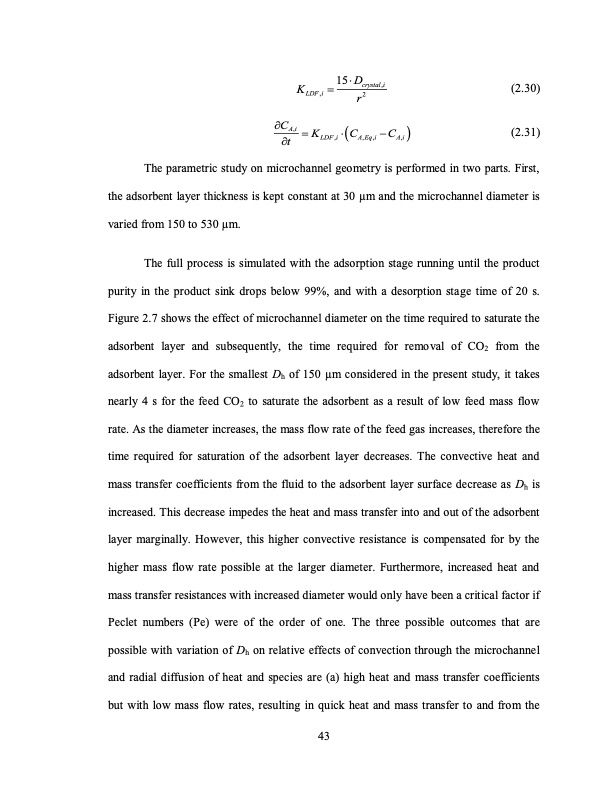
PDF Publication Title:
Text from PDF Page: 070
K 15Dcrystal,i (2.30) LDF,i r2 CA,i K C C (2.31) LDF ,i A,Eq,i A,i t The parametric study on microchannel geometry is performed in two parts. First, the adsorbent layer thickness is kept constant at 30 μm and the microchannel diameter is varied from 150 to 530 μm. The full process is simulated with the adsorption stage running until the product purity in the product sink drops below 99%, and with a desorption stage time of 20 s. Figure 2.7 shows the effect of microchannel diameter on the time required to saturate the adsorbent layer and subsequently, the time required for removal of CO2 from the adsorbent layer. For the smallest Dh of 150 μm considered in the present study, it takes nearly 4 s for the feed CO2 to saturate the adsorbent as a result of low feed mass flow rate. As the diameter increases, the mass flow rate of the feed gas increases, therefore the time required for saturation of the adsorbent layer decreases. The convective heat and mass transfer coefficients from the fluid to the adsorbent layer surface decrease as Dh is increased. This decrease impedes the heat and mass transfer into and out of the adsorbent layer marginally. However, this higher convective resistance is compensated for by the higher mass flow rate possible at the larger diameter. Furthermore, increased heat and mass transfer resistances with increased diameter would only have been a critical factor if Peclet numbers (Pe) were of the order of one. The three possible outcomes that are possible with variation of Dh on relative effects of convection through the microchannel and radial diffusion of heat and species are (a) high heat and mass transfer coefficients but with low mass flow rates, resulting in quick heat and mass transfer to and from the 43PDF Image | TEMPERATURE SWING ADSORPTION PROCESSES FOR GAS SEPARATION

PDF Search Title:
TEMPERATURE SWING ADSORPTION PROCESSES FOR GAS SEPARATIONOriginal File Name Searched:
PAHINKAR-DISSERTATION-2016.pdfDIY PDF Search: Google It | Yahoo | Bing
CO2 Organic Rankine Cycle Experimenter Platform The supercritical CO2 phase change system is both a heat pump and organic rankine cycle which can be used for those purposes and as a supercritical extractor for advanced subcritical and supercritical extraction technology. Uses include producing nanoparticles, precious metal CO2 extraction, lithium battery recycling, and other applications... More Info
Heat Pumps CO2 ORC Heat Pump System Platform More Info
| CONTACT TEL: 608-238-6001 Email: greg@infinityturbine.com | RSS | AMP |